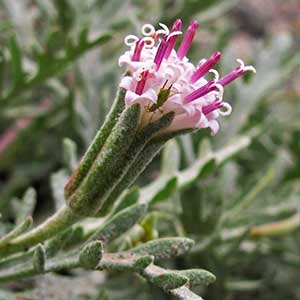Chaenactis thompsonii
Chaenactis fremontii
Thompson's pincushion
desert pincushion, Fremont pincushion, Fremont's pincushion, pincushion flower
mostly 5–15+, ascending to erect.
mostly 1–12;
branches mainly proximal.
mostly cauline, 2–5 cm;
largest blades ± elliptic, ± plane, 1-pinnately lobed;
lobes mostly 2–5 pairs, remote, ± plane.
basal (withering) and ± cauline, 1–7(–10) cm;
largest blades linear and terete or ± elliptic and plane, ± succulent, 0–1-pinnately lobed;
lobes 1–2(–5) pairs, remote, ± terete.
ascending to erect, 2–5 cm.
2–8(–10) cm, distally usually ± stipitate-glandular and, sometimes, ± arachnoid (at least early, often glabrescent by fruit).
± obconic.
± hemispheric to obconic (bases pale and ± truncate in fruit).
corollas white to pinkish, 5–8 mm (inner);
peripheral corollas spreading, zygomorphic, enlarged.
7–9 mm.
longest (10–)12–15 mm;
outer closely lanuginose, not stipitate-glandular, apices erect, ± rigid.
longest 8–10(–12) mm;
outer usually glabrescent in fruit, apices erect, acute, ± rigid.
mostly 1–3 per stem.
(± radiant) mostly 1–5 per stem.
7–9 mm (eglandular);
pappi: longest scales 3.5–5 mm.
(3–)6–8 mm;
pappi of (1–)4(–5) scales in 1 series, longest scales 6–8.5 mm, lengths 1–1.3 times corollas (apices visible among corollas at flowering).
= 10.
Chaenactis thompsonii
Chaenactis fremontii
Of conservation concern.
Chaenactis thompsonii appears to be sister to C. evermannii; it is known from the mountains of central and northwestern Washington. The similar habits of C. thompsonii and C. ramosa (= C. douglasii var. douglasii) appear to result from convergent evolution in the distinctive habitat of their type localities (Wenatchee Mountains), not from a close genetic relationship as suggested by Cronquist.
(Discussion copyrighted by Flora of North America; reprinted with permission.)
Chaenactis fremontii is often the most abundant spring wildflower in the lower Mojave and northern Sonoran deserts, where it is reported to be a significant food source for desert tortoises (Gopherus agassizii Cooper). It also extends seaward into the southern San Joaquin Valley area of west-central California, often as hybrids with other taxa (see sectional discussion).
The involucre bases described above are characteristic of Chaenactis fremontii and can help separate it from some forms of C. stevioides.
(Discussion copyrighted by Flora of North America; reprinted with permission.)


